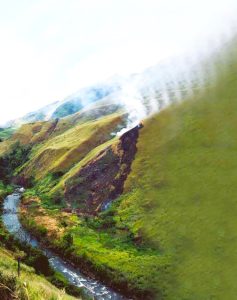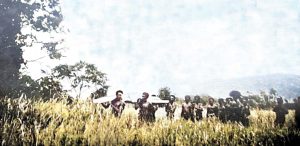Matapui – Part Three
By Ekke Beinssen
 Parts One and Two of this article were published in previous editions of PNG Kundu. They were taken from an account written by Ekke Beinssen of a 1929 exploratory expedition to find the source of the gold being sluiced out of the Bulolo and Edie Creek goldfields. This third part describes the frantic attempt to carry the sick and dying geologist Zakharov to a rendezvous to fly him from Garaina to hospital in Salamaua.
Parts One and Two of this article were published in previous editions of PNG Kundu. They were taken from an account written by Ekke Beinssen of a 1929 exploratory expedition to find the source of the gold being sluiced out of the Bulolo and Edie Creek goldfields. This third part describes the frantic attempt to carry the sick and dying geologist Zakharov to a rendezvous to fly him from Garaina to hospital in Salamaua.
Gerepo, the first village between Piaru and Garaina, which the locals had told us we would reach in a day, can’t be far away now. Naie thinks he can smell smoke, so I send him on ahead to locate the village. After an hour he comes back, holding the huge hand of a native man. I have never seen such an enormous human being. He looks like one of those fairytale giants who eats a naughty child for breakfast. His dress shows me that he is from the Waria Valley. With a grin a metre wide and a terrible ‘Uuaah’, he greets me, and in the manner of mission natives, gives me a firm hearty handshake which almost splinters my bones. I just manage to prevent him from greeting Zakharov in a similar manner.
He guides us now, and an hour or so later we arrive at a clearing where 20 Gerepo villagers are warming themselves by a fire. Heaven only knows how the news could have preceded us, but the entire Waria Valley seems to know that a sick white man is being carried to Garaina. The native missionaries have sent these men to widen the path for the stretcher. They have done it well, and our progress is now quicker and easier, but our carriers are exhausted. On top of that, we are now ambushed by a heavy shower of rain, so we stop early and set up camp for the night under the dense protective shelter of the dripping rainforest.
Finally on the afternoon of the following day, four days after leaving Piaru, we reach Garepo. We bed Zakharov down in a hut. He has been in an exhausted sleep for the past hours. I enquire about the state of the track ahead and how far it is to Garaina. Again, I am told: ‘If you walk quickly—two days.’ At our pace it will take us at least three or four days and this means we will arrive in Garaina two whole days, too late to meet the arranged flight. I decide to send a runner ahead to tell the pilot that we will be late. If he cannot wait for us, he is to return in another three days, that is on the 12th of February.
At first the track follows grassy slopes and is quite wide and easy, but soon it turns into a narrow forest trail again. It is the same fairytale forest of the dividing range, just a small portion of the vast jungles of New Guinea; so dark, so hushed, hiding so many undiscovered secrets. I am awed by its eeriness and vastness, and its impenetrability.
There is now a need for three men with machetes and axes to go ahead and widen the track for the stretcher. We walk through a round green vault and the denseness of the bush lessens only when we come to a stream, allowing us to glimpse the blue sky above. I am aware of my own illness, and I have a terrible feeling of light-headedness. On one occasion I go ahead and lie down on the moist moss beside a creek for a brief rest. The voices of the porters rouse me and reawaken the realisation of our dreadful reality. Although we continue until dusk, I estimate that we have not even completed half a day’s march.
That night Zakharov is very feverish and hallucinates in Russian. I can only understand an occasional word and it is often hard to make out whether he is dreaming, or awake and uttering a request. I hardly sleep so that I can be easily roused. I spend the night in a dozy state between tiredness and worry, very aware that my friend’s condition is deteriorating.
Next morning I tell the porters to slow down a bit to make it more comfortable for the sick man. Zakharov says, as I bend over him: ‘It is a race; but there is another racing us, and he will win’. I try to reassure him, but I know only too well that death is competing with us.
Finally they arrive at the airstrip at Garaina to hear that a plane had made several unsuccessful attempts to land due to bad weather.
Beinssen writes:
I have lost hope that the plane will come. I have also given up hope for Zakharov. Even though he is now sleeping peacefully, his breathing comes in short gasps. He did not regain consciousness during the night. Naie now calls to tell me that Zakharov has woken but he is not fully conscious. He asks: ‘Has my wife arrived?’ ‘No,’ I reply, but quickly collect myself and tell him: ‘… but she is waiting for you in Rabaul.’ ‘If that is the case, all will be well,’ he says, and then falls asleep again. I realise he is no longer in pain. I stay beside him. Perhaps he will come to and want to say more. Two hours pass and then he sits up with the last of his strength and gazes at me with a long, silent look as if he wants to say something more, and then falls across the bed. My friend has passed away. It is the morning of February the 13th.
I bury him that evening. In this hot and humid climate that task always has to be done quickly. We can’t make him a coffin, so we wrap him in his coat and sew him into a tarpaulin like a soldier.
Our twelve porters and the entire male population of Garaina accompany him on his last journey. The procession winds through the high grass to the spot at the edge of the jungle that I have chosen as his last resting place. By the time the sun sets, a cross has been erected on the new grave mound.
Soon after Zakharov was buried beside the airstrip at Garaina, the plane finally arrived and was able to land. Beinssen was seriously ill with dysentery and had urgent surgery in Sydney to remove a cyst on his liver.
He never returned to New Guinea, but he later wrote that his memories were the gold he brought back with him to Australia.
The full story, about 100 pages with photos, can be accessed via the PNGAA website: HERE




